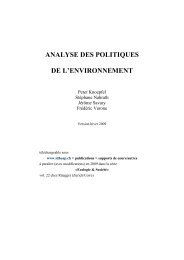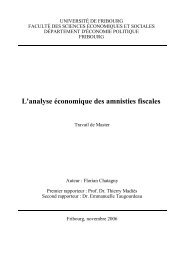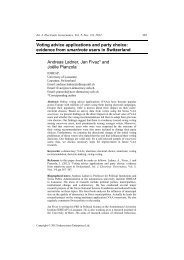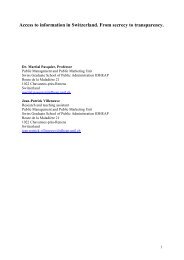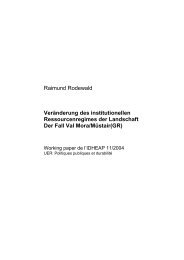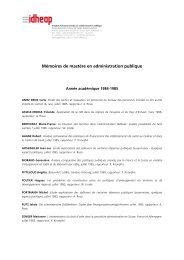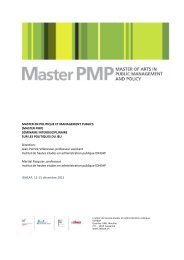Historical Analysis of Institutional Regimes in Switzerland ... - IDHEAP
Historical Analysis of Institutional Regimes in Switzerland ... - IDHEAP
Historical Analysis of Institutional Regimes in Switzerland ... - IDHEAP
Create successful ePaper yourself
Turn your PDF publications into a flip-book with our unique Google optimized e-Paper software.
22<br />
Property Rights: The ownership structure <strong>of</strong> Swiss forest was quite stable dur<strong>in</strong>g the last century.<br />
About three quarters <strong>of</strong> the forests belong to the public sector and one quarter is privately owned.<br />
90% <strong>of</strong> the publicly owned forest belongs to local authorities, municipalities and local public<br />
corporations. The average size <strong>of</strong> private plots is quite small (1 hectare on average), publicly-owned<br />
land amounts to 237 hectares.<br />
The regulative system for forests has its legal basis <strong>in</strong> the Federal Swiss Constitution and <strong>in</strong> the Swiss<br />
Civil Code, and ma<strong>in</strong>ly <strong>in</strong> forest law. The constitutional article <strong>of</strong> 1874 on the forest police <strong>in</strong> high<br />
altitude areas authorised the Federal State to preserve the country’s forests. The Swiss Civil Code <strong>of</strong><br />
1907 states that the public has free access to all forests, whether privately or publicly owned (all<br />
irrespective <strong>of</strong> the ownership <strong>of</strong> the forests, Swiss Civil Code Article 699). The public has also free<br />
access to mushrooms - up to a certa<strong>in</strong> quantity - and free access to berries, whereas game is state<br />
property. In case <strong>of</strong> unsusta<strong>in</strong>able use, cantons can restrict the gather<strong>in</strong>g <strong>of</strong> berries or mushrooms.<br />
Thus, propriety and use rights are strongly restricted by law. With respect to the right <strong>of</strong> alienation,<br />
the old law on forest police stipulates (Article 33) that partition<strong>in</strong>g <strong>of</strong> forests is subject to<br />
authorisation by cantons. These regulations were <strong>in</strong>tensified <strong>in</strong> 1945 (Leimbacher/Perler 2000: 235).<br />
The new Law on Forests (Article 25 WaG) states that the sale <strong>of</strong> forests belong<strong>in</strong>g to local<br />
authorities and corporations as well as partition<strong>in</strong>g <strong>of</strong> forest are still subject to cantonal authorisation<br />
and can only be granted when forest functions are not endangered. Deforestation is prohibited<br />
(Article 5 WaG) and forests must be managed so as to ensure that they function <strong>in</strong> a susta<strong>in</strong>able<br />
manner (Article 20 WaG). Even harvest<strong>in</strong>g <strong>of</strong> trees is subject to authorisation by forestry services<br />
(Article 20 al. 1 WaG).<br />
Policy Design: The policy design def<strong>in</strong>es use aims and policy <strong>in</strong>struments (e.g. afforestation plans),<br />
describes adm<strong>in</strong>istrative structures and, thus, modifies the basic regulations. The resource forest is<br />
<strong>in</strong>terest<strong>in</strong>g <strong>in</strong> that, as <strong>in</strong> many other European countries, it is a very old policy field with a<br />
correspond<strong>in</strong>g abundance <strong>of</strong> regulations and chang<strong>in</strong>g levels <strong>of</strong> scarcity with regard to the goods and<br />
services based on it. Major catastrophes, such as landslides and large-scale flood<strong>in</strong>g, as well as the<br />
pressure <strong>of</strong> population growth and newly established <strong>in</strong>dustries led to the decimation <strong>of</strong> Swiss forests<br />
dur<strong>in</strong>g the 19 th century and to the adoption <strong>of</strong> a new article <strong>in</strong> the Federal Constitution <strong>in</strong> 1874.<br />
Whereas the forest police law <strong>of</strong> 1876 protected forests <strong>in</strong> high-altitude areas, the law <strong>of</strong> 1902<br />
affected all forests <strong>in</strong> the country and rema<strong>in</strong>ed <strong>in</strong> force until the late 1980s.<br />
Preservation <strong>of</strong> the forest cover was and is an <strong>of</strong>ficial policy goal, and as a quantitative objective,<br />
forest area may not be reduced. The above-mentioned policy goal is enforced by a strong legal<br />
def<strong>in</strong>ition <strong>of</strong> forests, prohibition <strong>of</strong> deforestation, a ban on clear-cutt<strong>in</strong>g and an obligation to provide<br />
compensation <strong>in</strong> k<strong>in</strong>d for deforested areas. The purpose <strong>of</strong> the new Federal Law on Forests is<br />
broader and aims to ensure conservation <strong>of</strong> forests <strong>in</strong> their present volume, protect them as natural<br />
environment, ensure their capability to fulfil several functions and develop forestry and protect the<br />
population from natural catastrophes (Article 1 WaG). Thus, the objectives take the <strong>in</strong>terests <strong>of</strong><br />
environmental organisations and forest economy <strong>in</strong>to account.<br />
From the outset, forest policy used a mix <strong>of</strong> <strong>in</strong>struments. Whereas at the beg<strong>in</strong>n<strong>in</strong>g, regulative and<br />
organisational <strong>in</strong>struments were dom<strong>in</strong>ant for the preservation <strong>of</strong> forest cover, greater emphasis was<br />
later placed on f<strong>in</strong>ancial <strong>in</strong>centives. S<strong>in</strong>ce the mid-1980s, subsidies have become the most important<br />
steer<strong>in</strong>g <strong>in</strong>strument for the ma<strong>in</strong>tenance <strong>of</strong> forests. (Kissl<strong>in</strong>g/Zimmermann 1996: 60ff.) With regard to<br />
the form taken by the latter, f<strong>in</strong>ancial aid and <strong>in</strong>demnities have been allocated for preservation <strong>of</strong><br />
forest lands and <strong>in</strong>frastructure. In the early 1980s, due to the consequences <strong>of</strong> Waldsterben (i.e.



